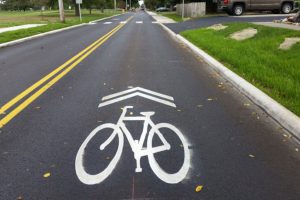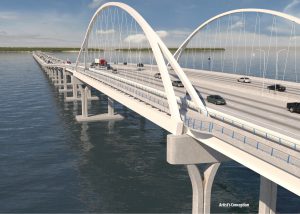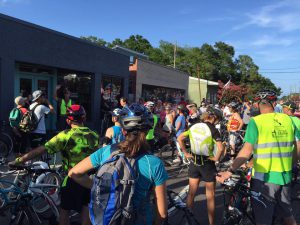
You have likely driven down roads painted with arrows and a stenciled bicycle, but may not be familiar with what these designations actually mean. Dubbed with the portmanteau “sharrow,” for “share-arrow,” it’s simply a traffic lane meant to be shared equally by cars and bicycles. These differ in function and layout from designated bike lanes, which are indicated by a solid white line and cyclist stencil on the edge of the road. Sharrows occur where no bike lanes exist.
Numerous efforts have been undertaken locally to make streets, especially those in the city of Pensacola limits, safer and more bike-friendly. These efforts include bike racks, brightly painted crosswalks, and the aforementioned sharrows.

These safety measures are much needed—sadly, Florida leads the nation in bicycle deaths. In 2021, almost 6,000 bicycle collisions occurred in the state, with more than 5,500 injuries and 169 deaths. The vast majority of these collisions were the result of vehicle crashes. Among those deaths, 83% were considered the fault of the vehicle driver, and not erratic or dangerous cyclist behavior. Last fall, a friend and fellow environmental professional was killed on her last training ride before leaving for an Ironman competition. She was hit in Tampa—the leading region of Florida for bicycle wrecks.
Many stretches of Escambia County have no sharrows, bike lanes, or sidewalks, and riders are forced to take their lives in their hands and travel on dark, unprotected roads—and the most dangerous are often long stretches like Highway 98 or Highway 90, where vehicles can pick up serious speed.

Research into the most effective ways to move vehicle and bicycle traffic safely show that building protected bike lanes with a physical barrier—often concrete—between riders and drivers is the safest. The new 3-Mile bridge from Pensacola to Gulf Breeze is a great example of this type of safer barrier. These, of course, are much more expensive to build than painting lanes on the roads, and are less common.
A recent article in Momentum magazine made the argument that sharrows are less safe than regular bike lanes, because most drivers don’t fully understand their function or how to drive safely within them. Drivers are typically impatient with slower-moving bikes and make dangerous decisions about how to behave. Making the situation worse, many of the local car vs bike deaths are hit and runs, with drivers leaving the scene of the accident without rendering medical aid to a victim who may have otherwise survived if given help.

Biking in the Pensacola area does not need to be dangerous. There are many safe places and efforts to create more routes for riders. Because of incomplete infrastructure throughout our communities, the City of Pensacola has worked to create a list of safe riding routes. These include a 9-mile route from “uptown” to downtown, and two 3.9 mile routes through parks and residential areas north and south of Creighton Road. Each year, numerous community organizations come together to celebrate “Ciclovia” downtown, and Bike Pensacola sponsors monthly “Slow Rides” that bring cyclists of all ages together to ride.
For dedicated bike trails, I highly recommend the paved, 17-mile Blackwater Heritage Trail in Milton and the 28-mile Hugh Branyon Backcountry Trail at Gulf State Park in Baldwin County, Alabama. Efforts are also underway to create the “Bluffline,” a biking trail that would run along the railroad tracks from Scenic Highway to Warrington.
Enjoy this beautiful spring weather–drive and bike safely out there!
 5
5
